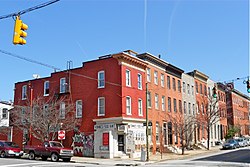Butchers Hill, Baltimore
Butchers Hill Historic District | |
 The corner of Chester and Pratt Streets, March 2012 | |
39°17′29″N 76°35′13″W / 39.29139°N 76.58694°W / 39.29139; -76.58694 | |
| Area | 57 acres (23 ha) |
|---|---|
| Architectural style | Late Victorian |
| NRHP reference No. | 82001582 [1] |
| Added to NRHP | December 28, 1982 |
Butchers Hill is a neighborhood in Southeast Baltimore, Maryland, United States. It is north of Fells Point, east of Washington Hill, and northwest of Patterson Park. It is south of Fayette Street, west of Patterson Park Avenue, north of Pratt Street, and east of Washington Street. It is in the 21231 zip code.
Established as a village before the Civil War, Butchers Hill was once home to butchers and poultry preparers, many of them German American and Jewish American. It was once more affluent than nearby Fells Point, as reflected in its generally larger rowhouses. Butchers Hill is near more gentrified sections of Fells Point, Patterson Park, and Johns Hopkins Hospital. A portion of it is a historic district listed on the National Register of Historic Places.[2]
In the 21st century, the neighborhood is popular among young professionals, artists, and students, residents, and staff at the nearby Johns Hopkins School of Medicine and Johns Hopkins Hospital. It is one of the neighborhoods where full-time employees of Johns Hopkins may apply for "Live Near Your Work" grants toward down payments on homes.
Laura Lippman's novel Butchers Hill tells the story of a private investigator working in this part of Baltimore.
Demographics
As of the census[3] of 2010, there were 1,967 people living in the neighborhood. The racial makeup of Butchers Hill was 51.9% White, 25.4% African American, 3.3% Native American, 2.6% Asian, 3.4% from other races, and 2.6% from two or more races. Hispanic or Latino of any race were 16.7% of the population. 43.6% of occupied housing units were owner-occupied. 24.6% of housing units were vacant. Butchers Hill is a popular neighborhood for students from the nearby Johns Hopkins medical campus.
74.6% of the population were employed, 2.3% were unemployed, and 23.1% were not in the labor force. The median household income was $36,636. About 23.9% of families and 23.5% of the population were below the poverty line.
Butchers Hill is home to many Irish-Americans, Polish-Americans, and Ukrainian-Americans, as well as African-Americans, Lumbee Native Americans, and a growing Hispanic and Latino population.[4]
References
- ^ "National Register Information System". National Register of Historic Places. National Park Service. March 13, 2009.
- ^ William J. Pencek Jr. (August 1982). "National Register of Historic Places Registration: Butchers Hill Historic District" (PDF). Maryland Historical Trust. Retrieved April 1, 2016.
- ^ "U.S. Census website". United States Census Bureau. Retrieved January 31, 2008.
- ^ "When questions of urban living steer their way into our vision". The Baltimore Sun. Retrieved April 17, 2015.
External links

- "These East Baltimore Neighborhoods are Moving Toward a Resurgence," D. C. Culbertson, Baltimore Sun
- Butchers Hill Association
- Butchers Hill Historic District
- Demographics from Neighborhood Indicators Alliance
- Butchers Hill Historic District, Baltimore City, including photo from 2004, at Maryland Historical Trust
- Boundary Map of the Butchers Hill Historic District, Baltimore City
- v
- t
- e
- Abell
- Barclay
- Bellona-Gittings
- Better Waverly
- Cameron Village
- Charles Village
- Cedarcroft
- Chinquapin Park-Belvedere
- Cold Spring
- Cylburn
- Edgecomb
- Evergreen
- Glen Oaks
- Govans
- Guilford
- Hampden
- Harwood
- Hoes Heights
- Homeland
- Homewood
- Keswick
- Koreatown
- Lake Evesham
- Lake Walker
- Loyola-Notre Dame
- Medfield
- Mount Washington
- Oakenshawe
- The Orchards
- Pen Lucy
- Poplar Hill
- Radnor-Winston
- Remington
- Roland Park
- Sabina Mattefeldt
- Stone Hill
- Tuscany-Canterbury
- Village of Cross Keys
- Waverly
- Woodberry
- Wyman Park
- Wyndhurst
- Belair-Edison
- Beverly Hills
- Cedonia
- Coldstream-Homestead-Montebello
- Ednor Gardens-Lakeside
- Frankford
- Gardenville
- Govans
- Hamilton Hills
- Hillen
- Lauraville
- Loch Raven
- Mayfield
- Mid-Govans
- Morgan Park
- Northwood
- Overlea
- Ramblewood
- Stonewood-Pentwood-Winston
- Taylor Heights
- Waltherson
- Wilson Park
- Woodbourne Heights
- Barclay
- Berea
- Broadway East
- Coldstream-Homestead-Montebello
- East Baltimore Midway
- East Monument
- Ellwood Park
- Four By Four
- Greenmount West
- Johnston Square
- Latrobe Homes
- Madison-Eastend
- McElderry Park
- Middle East
- Milton-Montford
- Old Town
- Oliver
- Orangeville
- Patterson Park
- South Clifton Park
- Beechfield
- Carrollton Ridge
- Dickeyville
- Franklintown
- Gwynn's Falls
- Hollins Market
- Irvington
- Morrell Park
- Oaklee
- Pigtown
- Saint Agnes
- Sowebo
- Ten Hills
- Union Square
- Violetville
- Wakefield
- Washington Village
- Yale Heights
- Allendale
- Armistead Gardens
- Bel Park Towers
- Claremont
- Douglass Homes
- Ellerslie Homes
- Flaghouse Homes
- Govans Manor Homes
- Heritage Crossing
- Lafayette Court
- Latrobe Homes
- Mason Homes
- Lakeview Towers
- McCulloh Homes
- O'Donnell Heights
- Perkins Homes
- Pleasent View Gardens
- Poe Homes
- Primrose Place
- Somerset Courts
- Carroll Park
- Clifton Park
- Cylburn Arboretum
- Druid Hill Park
- Federal Hill Park
- Fort McHenry
- Gwynns Falls Park
- Hanlon Park
- Herring Run Park
- Lake Roland Park
- Middle Branch Park
- Mount Pleasant Woods Park
- Leakin Park
- Patterson Park
- Riverside Park
- Sherwood Gardens
- Wyman Park














